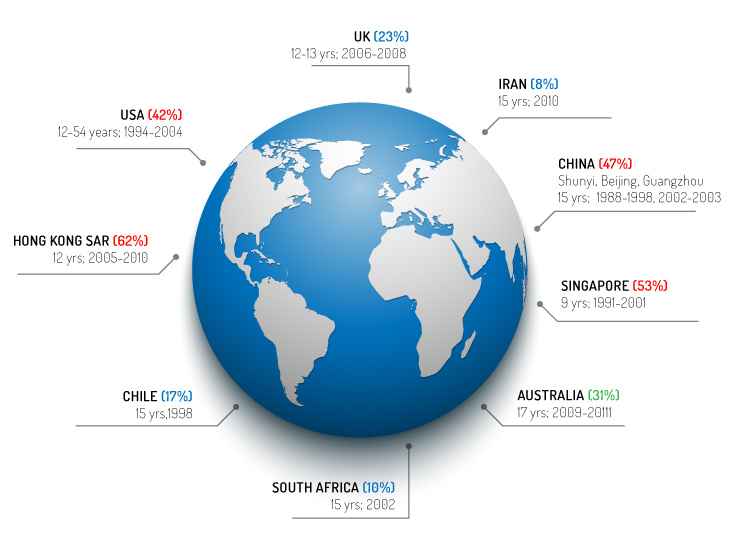
The Rate of Short Sightedness (Myopia) is Climbing in Children. Should we be Concerned?
Myopia is on the rise in this digital world including here in New Zealand and contrary to popular belief, the usual glasses are not the best way to treat children’s myopia.
It’s important parents understand the causes, symptoms and lifelong complications caused by short-sightedness. We also share tips with you below on how to slow down its progression and thereby reduce long term harm that can be caused to children in later life.
What Is Myopia?
Myopia is a condition where light is focused in front of the retina, causing blurred distance vision. People with myopia often see quite clearly at close range but distant objects are blurred. Myopia usually starts during childhood, typically progressing until late adolescence, but may progress into adulthood.
How common is it?
In 1983 the typical onset of short sightedness for New Zealand children was around 11 years of age. Fast forward to 2000, and the onset had reduced to just eight years of age (The Australia and New Zealand Child Myopia Report – A Focus on Future Management). That last statistic is now more than 20 years old, so what is happening today?
While current research data for New Zealand (along with other countries) is overdue, here is a global snapshot of myopia based on the most recent studies (image source: the International Myopia Institute)

The Sydney Myopia Study1 found 31% of 17 year olds were myopic, double the prevalence reported by the Blue Mountain Eye Study2 more than a decade previous.
For some Asian countries, it has been reported that myopia affects an alarming 80-90 percent of school leavers (AsianScientist, 8 May, 2012)
Why is Myopia so Concerning?
Children with myopia have an increased chance of developing potentially blinding eye conditions later in life such as retinal detachment, cataracts, glaucoma and macular degeneration. These conditions are actually far from rare: myopia maculopathy, a condition where there is a gradual death of the retinal cells, is a common cause of visual loss, ahead of diabetic eye disease.
These risks increase as the rate of myopia worsens. This is why it is so important to identify myopia risk early on and take active steps to slow its progression.
How is Myopia is Identified and Treated in Children?
In New Zealand there is currently only a routine vision check for children at seven years of age in schools. As this eye test does not include screening for myopia, the condition can be missed in children. Private optometrists however will automatically screen for myopia, among other eye conditions.

While normal spectacles and contact lenses will correct the blurred vision and help your child see clearly, they won’t slow down the worsening of myopia. Recently special types of spectacles and contact lenses have been developed specifically to do this. Low dose atropine eye drops have also been shown to help slow myopia. Ask your optometrist about which of these options may best suit your child and is often used in combination with other means of myopia control.
As a Parent, What can you Do?
Look out for early signs
The earlier you catch signs of myopia the better. Familiarise yourself with the symptoms of myopia and pay close attention to how your child interacts with their environment. This includes a child reluctant to move away from the TV or squinting their eyes to see in the distance.

Book regular eye tests
Younger children may not realise or be able to communicate that there is a problem with their vision, which makes regular eye tests important. An eye care professional will be able to examine your child’s eyes to assess their vision and eye health.
Enforce breaks from close work
Reading, learning from screens and doing homework are important for children and teens, but they should take short breaks from close work every 20 minutes to relax the focussing muscles of the eyes. Keeping at least a forearm’s distance between their eyes and their close work at all times helps to reduce eye strain and the risk of developing myopia.
Limit screen time
Younger and younger children are using smartphones and tablets regularly. Too much screen time is linked to myopia, eye strain and dry eye symptoms. School-aged children and teens should ideally not spend more than two hours per day outside of school on screen time.

Encourage time outdoors
There is good evidence to suggest that exposure to the outdoors and natural light is beneficial in preventing the onset of myopia and possibly slowing the progression of myopia too. Children should be encouraged to spend 90 minutes outdoors every day, whether that’s walking, relaxing or playing sport (but should make sure to wear a hat and sunglasses and seek shade to prevent UV damage).
Is it time to come and see us?
It will take just two minutes to book an appointment online with our family-friendly team of Wellington optometrists. Choose from either our central Lower Hutt or Johnsonville locations to book your child’s eye test.
1 French AN, Morgan IG, Burlutsky G, Mitchell P, Rose KA. Prevalence and 5- to 6-year incidence and progression of myopia and hyperopia in Australian schoolchildren. Ophthalmology 2013;120:1482-91.
2 Attebo K, Ivers RQ, Mitchell P. Refractive errors in an older population: the Blue Mountains Eye Study. Ophthalmology 1999;106:1066-72.

